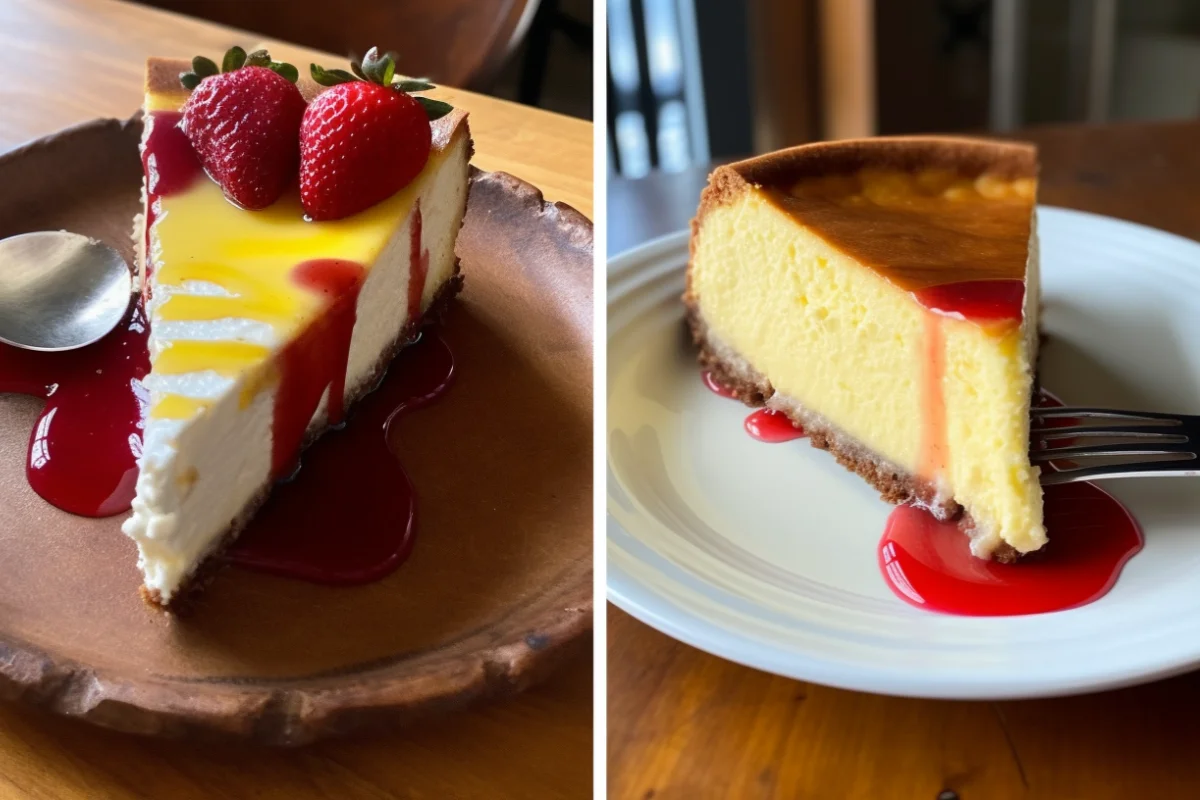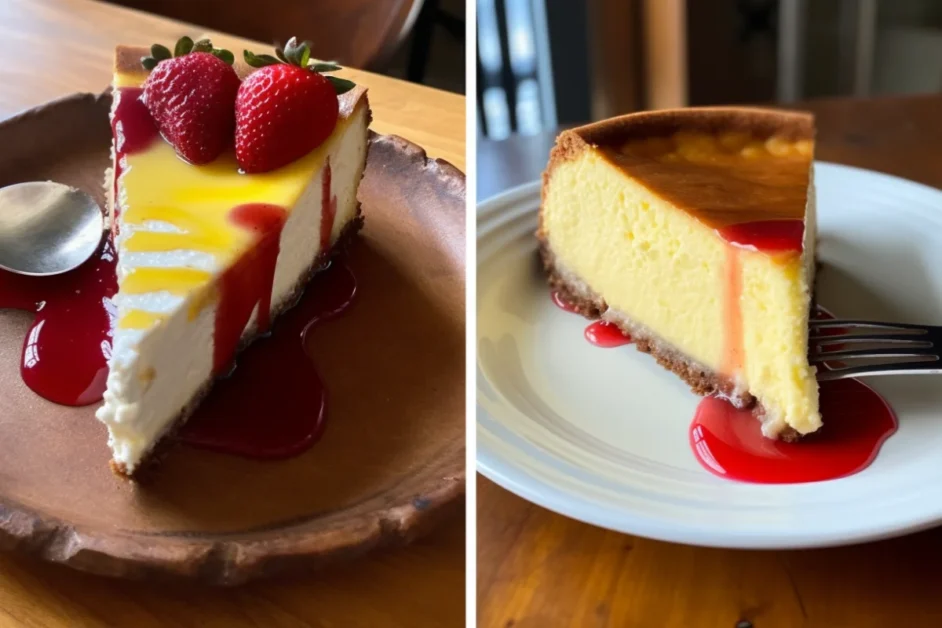
Cheesecake is a beloved dessert worldwide, but American and Italian cheesecakes differ in key ways such as ingredients, texture, and flavor.
Introduction
Cheesecake is one of the most universally adored desserts. Its creamy texture, variety of flavors, and flexibility to suit diverse culinary traditions have made it a favorite across the globe. However, the difference between American cheesecake and Italian cheesecake illustrates how a single dish can evolve into two distinct culinary masterpieces.
American cheesecake represents richness and indulgence, often characterized by its dense texture and bold flavor combinations. Italian cheesecake, on the other hand, prioritizes simplicity, lightness, and the natural sweetness of its ingredients. While both styles are undeniably delicious, their unique qualities make them suitable for different occasions and palates.
This comprehensive article explores the history, preparation methods, key differences, cultural significance, and modern adaptations of American and Italian cheesecakes. Whether you’re curious about their origins, planning to bake your own, or simply looking for your next dessert indulgence, this guide will provide everything you need to know about these iconic styles.
The Ancient Roots of Cheesecake
The Greek Foundations
Cheesecake dates back to ancient Greece, with origins as early as 2,000 BCE. Archaeologists discovered early cheesecake molds on the island of Samos, indicating its significance in Greek culture. Cheesecake was a staple at weddings and festivals, symbolizing prosperity. It was also a practical source of energy for athletes during the original Olympic games.
The Greeks’ version of cheesecake combined fresh cheese, honey, and wheat flour. This mixture was baked over open flames, creating a dish that was simple yet satisfying. The first recorded recipe appears in the writings of Athenaeus, further proving cheesecake’s importance in Greek culinary traditions.
Roman Adaptations
When the Romans conquered Greece, they adopted cheesecake, adding eggs to create a custard-like texture. This enhanced version, known as “libum,” was baked on hearthstones and offered during religious ceremonies. Roman soldiers and traders spread cheesecake across Europe, allowing it to evolve into diverse regional variations.
The Roman version of cheesecake incorporated local ingredients like goat’s milk cheese and honey, laying the foundation for modern Italian cheesecake. Its portability and shelf stability made it a popular dish for long journeys.
Medieval and Renaissance Cheesecake
In medieval Europe, cheesecake began to take on a sweeter profile with the introduction of sugar and exotic spices like cinnamon and nutmeg. Cheesecake recipes were often Protected in Abbeys and adapted according to local ingredients, such as curd cheese in Germany or mascarpone in Italy.
By the Renaissance, cheesecake had become a refined dessert, often served at Feasts and special occasions. Italian cooks, Inspired by their access to high quality dairy, began Blending ricotta and mascarpone into their recipes, setting the stage for modern Italian cheesecake.
The Evolution of American Cheesecake
Cheesecake arrived in America with European immigrants, but it wasn’t until the invention of cream cheese that it gained its distinct identity. In 1872, William Lawrence accidentally created cream cheese while attempting to replicate French Neufchâtel. This smooth, tangy ingredient became the foundation of American cheesecake.
The rise of New York-style cheesecake in the 20th century cemented cheesecake’s place in American culture. Restaurants like Lindy’s and Junior’s in New York City popularized this dense, indulgent dessert. Its association with urban sophistication and celebration made it a staple of American diners, bakeries, and family gatherings.
The Regional Diversity of Italian Cheesecake
Italian cheesecake reflects the country’s culinary diversity, with each region offering its unique take:
- Sicilian Cheesecake: Uses sheep’s milk ricotta and incorporates flavors like citrus zest, pistachios, and honey.
- Neapolitan Cheesecake: Includes wheat berries and orange blossom water, often served during Easter.
- Northern Italian Cheesecake: Favors mascarpone and may include nuts or liqueurs for a richer, more decadent flavor.
Unlike American cheesecake, Italian cheesecake remains closely tied to traditional family recipes and regional ingredients. It is often made at home for holidays and special occasions, emphasizing its artisanal nature.
Key Ingredient Differences

Cheese: The Foundation
The type of cheese used in cheesecake is the most Characterizing difference:
- American Cheesecake: Cream cheese provides a rich, smooth, and tangy base. Its high fat content ensures a dense, velvety texture.
- Italian Cheesecake: Ricotta cheese gives Italian cheesecake a lighter, slightly grainy texture. Mascarpone, often used in Northern Italy, creates a creamier, more luxurious consistency.
Sweeteners and Flavorings
American cheesecake recipes rely heavily on granulated sugar, complemented by bold flavors like chocolate, caramel, and peanut butter. Sour cream and heavy cream are often added to enhance richness.
In contrast, Italian cheesecake uses natural sweeteners like honey, paired with subtle Additives such as almond extract, lemon zest, or fresh fruits. This results in a more delicate sweetness that highlights the freshness of the ingredients.
Textural Differences
The Richness of American Cheesecake
American cheesecake is Equivalent with Luxury. Its thick, creamy filling is Accomplished through the combination of cream cheese, eggs, and heavy cream. This structure allows for Detailed designs and Extras, from fruit and fruit sauces to chocolate ganache. see this link for more details.
The Lightness of Italian Cheesecake

Italian cheesecake, in Contrast, feels lighter on the palate. Ricotta’s lower fat content produces an airy texture that pairs well with the natural Sugary taste of honey or citrus. This makes Italian cheesecake an ideal choice for those who prefer a dessert that is less heavy yet equally Delicious.
Crusts and Bases
American Cheesecake Crusts
The graham cracker crust is a Characteristic of American cheesecake, offering a crumbly, buttery base that Differences with the creamy filling. Variations include Oreo crusts, pretzel crusts, and nut based alternatives like almond flour crusts for gluten free options.
Italian Cheesecake Crusts
Italian cheesecakes often use a Butter cookies or almond pastry crust, adding a delicate crunch. In some regions, cheesecakes are baked without a crust, Permitting the filling to stand alone. Simple approach Focuses on The sweet’s natural flavors.
Baking Techniques
American Cheesecake: Mastering Precision
American cheesecakes are baked using a water bath to prevent cracks and ensure even cooking. Cooling the cheesecake Slowly is Necessary for Preserving its structure and smooth texture.
Italian Cheesecake: Celebrating Simplicity
Italian cheesecakes are Usually baked at lower temperatures, often without the need for a water bath. Many recipes are no-bake, relying on Refrigerating to set the filling. This approach makes Italian cheesecake easier to prepare while Protecting its light, airy texture.
Cultural Significance
Cheesecake in American Culture
In the United States, cheesecake is a symbol of Luxury and celebration. It is a staple at holidays, birthdays, and family Assemblies. Restaurants like The Cheesecake Factory have Raised cheesecake to a Traditional Happening, offering Innumerable Differences that cater to every taste.
Cheesecake in Italian Tradition
In Italy, cheesecake remains tied to tradition and Local pride. It is often made for religious holidays, such as Easter, and Represents
the importance of fresh, local ingredients. Unlike its American Equivalent, Italian cheesecake is less Marketed, Preserving its Heritage and Home cooked charm.
Modern Trends
Health-Conscious Variations
Cheesecake has evolved to meet modern dietary needs:
- Vegan Cheesecake: Made with cashew cream, coconut milk, or tofu.
- Gluten-Free Cheesecake: Almond or cocnut flour crusts replace Classic graham biscuit.
- Keto Cheesecake: Uses low carb Sugar Alternatives like stevia or monk fruit.
Fusion Cheesecakes
Globalization has inspired hybrid cheesecake styles, Mixing American Opulence with Italian Airiness. A ricotta based cheesecake with a graham cracker crust is one such fusion that Blends the best of both worlds.
Baking Tips from the Experts
- Use High-Quality Ingredients: The flavor and texture of your cheesecake depend on the quality of its ingredients.
- Avoid Overmixing: Overmixing introduces air, which can cause cracks during baking.
- Bake Slowly: Low temperatures and a water bath help achieve a smooth texture.
- Refrigerate Overnight: Cheesecake tastes best after resting in the fridge, Permitting flavors to meld.
Global Cheesecake Styles
Beyond American and Italian cheesecakes, other global styles offer unique Analyses:
- Japanese Cheesecake: Light, fluffy, and soufflé like.
- German Käsekuchen: Tart and creamy, made with quark cheese.
- Polish Sernik: Rich and spiced, often Showcasing rum or vanilla.
Conclusion
The difference between American cheesecake and Italian cheesecake Exhibits the beauty of Gastronomic Variety.American cheesecake represents Pleasure, with its rich Patterns and bold flavors, while Italian cheesecake offers Chicness and Clarity, Accentuating the natural Honeyed quality of its ingredients.
Exploring these styles allows us to appreciate the Traditional and Heritage value of cheesecake. Whether you prefer the creamy Degeneracy of American cheesecake or the refined Levity of Italian cheesecake, there’s no denying the Global appeal of this Enduring dessert.

